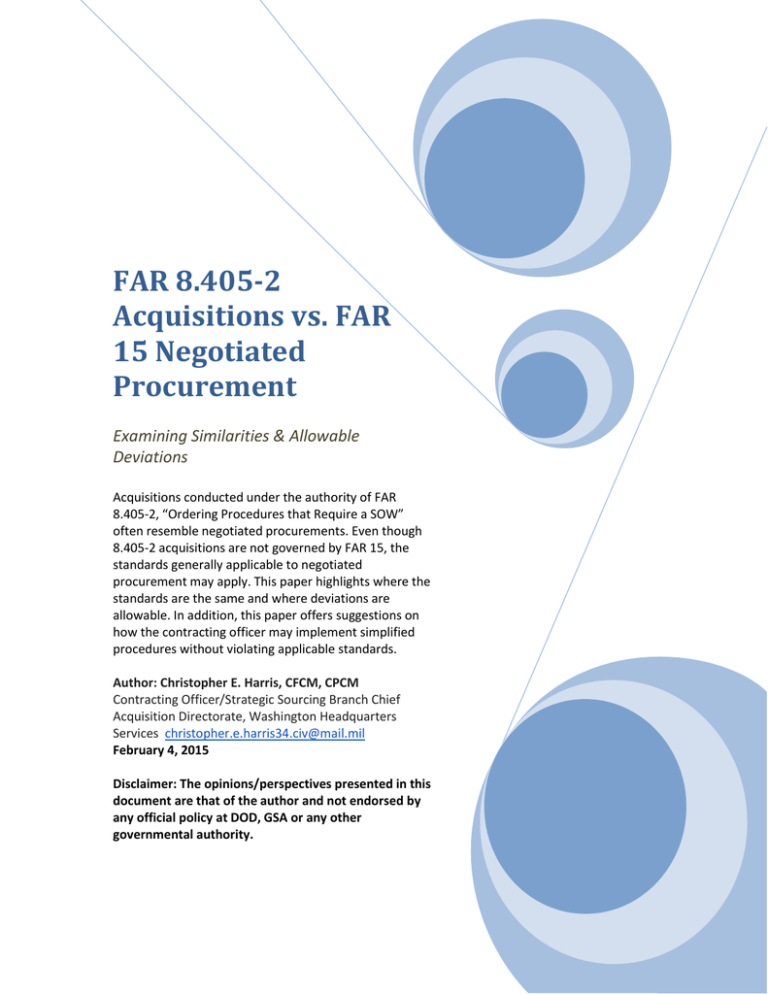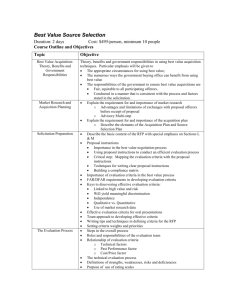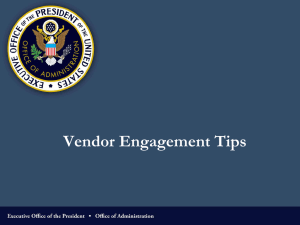FAR 8.405-2 Acquisitions vs. FAR 15 Negotiated Procurement
advertisement

FAR 8.405-2 Acquisitions vs. FAR 15 Negotiated Procurement Examining Similarities & Allowable Deviations Acquisitions conducted under the authority of FAR 8.405-2, “Ordering Procedures that Require a SOW” often resemble negotiated procurements. Even though 8.405-2 acquisitions are not governed by FAR 15, the standards generally applicable to negotiated procurement may apply. This paper highlights where the standards are the same and where deviations are allowable. In addition, this paper offers suggestions on how the contracting officer may implement simplified procedures without violating applicable standards. Author: Christopher E. Harris, CFCM, CPCM Contracting Officer/Strategic Sourcing Branch Chief Acquisition Directorate, Washington Headquarters Services christopher.e.harris34.civ@mail.mil February 4, 2015 Disclaimer: The opinions/perspectives presented in this document are that of the author and not endorsed by any official policy at DOD, GSA or any other governmental authority. FAR 8.405-2 Acquisitions vs. Negotiated Procurement Examining Similarities & Allowable Deviations Contents 1. Introduction ..................................................................................................................... 3 2. Applicable Negotiated Procurement Standards for Exchanges ...................................... 4 3. Allowable Deviations from Standards Applicable to Negotiated Procurements ............ 5 Price Reductions: ............................................................................................................ 5 Competitive Range Not Required: .................................................................................. 6 No Common Cut-Off Dates ............................................................................................ 6 4. Appendix I-Suggested Solicitation Evaluation Language .............................................. 8 Page 2 of 8 FAR 8.405-2 Acquisitions vs. Negotiated Procurement Examining Similarities & Allowable Deviations 1. Introduction The Federal Supply Schedule program is directed and managed by GSA and provides Federal agencies with a simplified process for obtaining commercial supplies and services at prices associated with volume buying. The MAS program manages various indefinite delivery contracts that are awarded to provide supplies and services at stated prices for given periods of time. FSS contracting simplifies the acquisition process by alleviating many of the CO’s preaward duties, such as, streamlined determination of fair and reasonable price1 elimination of the need for a separate responsibility determination2 elimination of the need to make a separate small business determination3, elimination of the debrief requirement4 a general exemption from FAR part 19 procedures5 and there is no mandate to evaluate past performance as a part of the award decision. However, the requirements related to exchanges in FAR part 8.4 procurements are not as clear cut. The CO has broad discretion in fashioning suitable evaluation procedures when using simplified processes, but the GAO has stated that where an agency issues an RFQ and thus shifts the burden to the vendors for selecting the items from their schedules, they will judge the propriety of the contracting officer’s actions in accordance with the standards that are generally applicable to negotiated procurements.6 In addition GAO case law suggests that when proposal revisions (i.e. discussions) are utilized in a FAR 8.4 environment, they must be meaningful.7 On the other hand, the Court of Federal Claims has held that FAR 15 procedures are not applicable to FSS orders even where the agency uses some of the more formal elements typically found in a negotiated procurement.8 Further, the court stated that case law suggests that the solicitation must be relatively clear of its intentions to use FAR 15 procedures in order to trigger their application. In addition, because FAR 15 procedures generally don’t apply, arguments that negotiated procurement standards such as “meaningful discussions” are applicable will generally fail.9 However, the Court stated that it will review the procurement process employed to ensure that it complies with the FAR’s requirement for fundamental fairness (reference FAR 1.102-2(c)(3)). As illustrated in the previous paragraphs, there are divergent opinions between GAO and COFC as to when FAR 15 procedures are invoked in the FAR 8.4 environment. It is 1 FAR 8.404(d); FAR 8.405-2(d); and Reep, Inc. B-290665 September 2002 Synergetics, Inc. B-299904 September 2007 3 “Can a Schedule Contractor Be of One Business Size on the Order and a Different Business Size on the Schedule Contract”, Clemens, Dave & Briest, Dan Avoiding MAS Confusion September 2011. 4 FAR 8.405-2(d) 5 FAR 8.405-5 6 CourtSmart Digital Systems B-292995.2/.3 7 USGC, Inc., B-400184.2/.3/.4 December 2008 and TDS, Inc., B-292674 November 2003. 8 Distributed Solutions, Inc. v. United States and Compusearch Software Systems, Inc. 2012 9 Id. 2 Page 3 of 8 FAR 8.405-2 Acquisitions vs. Negotiated Procurement Examining Similarities & Allowable Deviations suffice to say that, the GAO generally issues more conservative opinions pertaining to CO discretion and fairness in FAR 8.4 procurements while the COFC has issued opinions that are more permissive. Given the fact that the vast majority of bid protests are filed and resolved within the GAO forum10 from a risk management perspective, acquisition procedures should be designed to withstand the scrutiny of standards imposed by the GAO. In so doing, the agency can have more confidence that the procurement would survive a protest in either forum. Therefore, this treatise will identify the applicable negotiated procurement standards applied to exchanges in FAR 8.405-2, “Ordering Procedures for Services Requiring a SOW” (henceforth FAR 8.405-2) and the allowable deviations from those standards. With this information, the contracting professional should be able to effectively avoid undue litigation risks while taking advantage of streamlined exchange techniques that can be safely used in FAR 8.405-2 procurements. 2. Applicable Negotiated Procurement Standards for Exchanges 11 Exchanges pertinent to FAR 15 negotiated procurements include: clarifications, communications, and discussions. As a practical matter (assuming that the contracting officer does not form a competitive range), communications do not exist in FAR 8.405-2 acquisitions. However, clarifications and discussions are common tools used in FAR 8.405-2 acquisitions to obtain the best value quotation. (i) Clarifications: According to FAR 15.306, clarifications are limited exchanges between the agency and the offerors for the purpose of eliminating minor uncertainties or irregularities in a proposal and don’t give an offerors the opportunity to revise or modify its proposal. Further, the guidance says clarifications are not to be used to cure proposal deficiencies or material omissions, or materially alter the technical or cost elements of the proposal, or otherwise revise the proposal. One of the key time-saving elements of engaging in clarifications is that requesting clarifications from one offerors does not trigger the requirement to seek clarification from all other offerors12 and engaging in clarifications does not trigger the requirement to address strengths or weaknesses and other aspects of a quotation.13 The standard applied to clarifications under The article, “Pentagon Seeks to Shake Up Bid Protest Jurisdiction” by Dietrich Knauth states that in 2011 2,355 bid protests were filed with GAO while only 98 bid protests were decided by COFC. 11 It is useful to employ the FAR 15 terms “clarification” and “discussion” in this treatise because the GAO has stated in cases such as Kardex Remstar LLC (B-409030) that they will examine the substance of the agency’s actions concerning exchanges in FAR 8.4 procurements thru the prism of the definitions and rules related to FAR 15 exchanges. 12 Serco, Inc., B-406061/.2 February 2012; CH2M Hill Antarctic Support, Inc., B-406325/.2/.3 April 2012; PN&A, Inc. B-406368 April 2012; and International Medical Corps, B-403688 December 2010. 13 Pinnacle Solutions, Inc., B-406998/.2 October 2012. 10 Page 4 of 8 FAR 8.405-2 Acquisitions vs. Negotiated Procurement Examining Similarities & Allowable Deviations negotiated procurements is also applied to acquisitions conducted under the authority of FAR 8.405-2. However, as delineated by FAR 15.306, the CO must skillfully distinguish between clarifications and discussions so that he/she can both efficiently execute the procurement, but avoid unwittingly entering into discussions.14 (ii) Discussions: FAR 15.306 (d) defines discussions as communications that occur with an Offerors for the purpose of obtaining information essential to determine the acceptability of a proposal, or provides the Offerors with an opportunity to revise or modify its proposal in some material respect. In negotiated procurement if discussions are conducted they must be meaningful. At the GAO, the same standard is applicable to FAR 8.405-2 acquisitions.15 Agencies fulfill the requirement to conduct meaningful discussions when the agency addresses significant weaknesses, deficiencies, and adverse past performance to which the Offerors has not previously had the opportunity to respond. 3. Allowable Deviations from Standards Applicable to Negotiated Procurements Even though discussions must be meaningful and generally16 they must be conducted with all technically acceptable offerors, there is no requirement in FAR 8.405-2 procurements that an agency conduct discussions with vendors in accordance with FAR 15.306 procedures regarding the content of their responses.17 In keeping with the foregoing principle, the FAR and case law reveal that there are some distinct procedural methods that may be employed under FAR 8.405-2 acquisitions that are cardinal deviations from negotiated procurement standards. These procedures include price reductions, elimination of the need to form a competitive range, and no common cutoff dates. Price Reductions: Under the rules governing negotiated procurement, obtaining a price reduction is a proposal revision that triggers the requirement to conduct meaningful discussions with all offerors in the competitive range; therefore, the agency cannot solicit a revision to 14 Analysis Group, LLC, B-401726/.2 November 2009 and e-Mind, B-289902 May 2002. USGC, Inc., B-400184.2/.3/.4 December 2008 and TDS, Inc., B-292674 November 2003. 16 There are at least three exceptions to this general rule: (1) a revision is allowed and counted as a clarification if the vendor’s mistake is obvious (IPlus, Inc. B-298020 June 2006 & Joint Theatre Services, B278168/.2 Jan 1998); (2) acceptance of a late modification of a proposal from the otherwise successful offeror (FAR 52.215-1(C)(3)(ii)(B); Omega, B-298767 November 2006; and The SANDI Group, Inc., B401218 June 2009); (3) and in situations where an offeror though technically acceptable has no reasonableness chance of award (Dixon Group, B-406201 Dixon Group March 2012). 17 Marine Group Boat Works, LLC B-404277/.2 January 2011 15 Page 5 of 8 FAR 8.405-2 Acquisitions vs. Negotiated Procurement Examining Similarities & Allowable Deviations pricing without complying with the requirement to conduct meaningful discussions.18 In accordance with FAR 8.405-4, contracting officers are required to seek a price reduction for orders over the simplified acquisition threshold; accordingly GAO has ruled that compliance with this requirement does not trigger the requirement to conduct meaningful discussions.19 This is a very powerful tool because it allows the contracting officers to get a better deal for the Government without addressing other parts of an offeror’s quotation. If the contracting officer seeks a price reduction, every technically acceptable offeror should be given an opportunity to do so in order to avoid giving rise to competitive prejudice. Competitive Range Not Required: In negotiated procurement the contracting officer is required to establish a competitive range in order to negotiate. Establishing a competitive range includes writing a memo memorializing the CO’s decision concerning whom to include and exclude. In addition, the excluded offerors must be notified. Once notified, excluded offerors may request a preaward debrief and then decide whether to protest. In acquisitions conducted under the authority of FAR part 8.405-2, the contracting officer can negotiate with offerors without establishing a competitive range, without writing a memorandum that memorializes the contracting officer’s decision to exclude technically unacceptable vendors, and there is no need to notify offerors that they have been eliminated from the competition until the award decision is made. Although there is no requirement to form a competitive range for the purposes of negotiation, if the Government decides to negotiate, at a minimum, the CO must negotiate with all technically acceptable offerors20,but offerors who are not technically acceptable are not entitled to discussions.21 On the other hand, if the agency decides to limit negotiations to the most highly rated respondents (i.e. exclude some technically acceptable offerors), there should be documentation explaining the rationale for the agency’s decision to do so22. No Common Cut-Off Dates: In negotiated procurements the agency is required to provide a common cutoff date for the receipt of revised proposals. It is considered to be one of the basic requirements of competitive acquisition because it enables all offerors to compete on equal 18 Burchick Construction, B-400342 October 2008 Optimus Corporation, B-400777 January 2009 & Vion Corporation, B-283804.2 January 2000 20 Venturi Technology Partners, B-292060 2003 & Warden Associates, B-291238 December 2002. 21 Venturi Technology Partners, B-292060 2003 & Warden Associates, B-291238 December 2002. 22 See GBTI Solutions, Inc. (B-409114.3) where the agency formed a “negotiation range” (i.e. a FAR 8 style competitive range) and negotiated with the highest rated offerors only. In that case, the Government provided a decision document memorializing their decision to reduce the number of firms with which to negotiate. 19 Page 6 of 8 FAR 8.405-2 Acquisitions vs. Negotiated Procurement Examining Similarities & Allowable Deviations footing.23 In negotiated procurement discussions must begin and end at the same time so that vendors have the same amount of time to respond. If additional aspects of a vendor’s proposal need to be addressed after the first round of exchanges, the contracting officer must re-open discussions will all offerors in the competitive range. In FAR 8.405-2 procurements the contracting officer may hold discussions and receive revised quotations without regard for common cutoff dates.24 In addition, the agency may engage in multiple rounds of discussions with a subset of offerors as long as offerors are not treated disparately. That is, if the agency continues discussions with an Offeror about an issue that was previously raised but unresolved, or if new issues arise as a result of discussions, the agency may continue discussions with all similarly situated Offerors, but it does not have to reopen discussions with all respondents.25 23 Windham Power Lifts, B-214287.2 June 1984 Marine Group Boat Works, LLC; B-404277 January 2011 25 Front Line Apparel Group, B-295989 June 2005 24 Page 7 of 8 FAR 8.405-2 Acquisitions vs. Negotiated Procurement Examining Similarities & Allowable Deviations 4. Appendix I-Suggested Solicitation Evaluation Language (1) NON-PRICE NONREVISIONAL EXCHANGES The Government may engage in exchanges with offerors in order to clear up or amplify certain aspects of a quotation. These exchanges include the ability to submit additional information to amplify assertions already included in the quotation. In addition, among other things, these exchanges include: the opportunity to address the relevance of an offeror’s past performance information; the opportunity to address adverse past performance information to which the Offeror has not previously had an opportunity to respond; and the opportunity to resolve minor or clerical errors. (2) PRICE DISCOUNTS Price discounts may be requested at any time even if the initial quotation included them. A price reduction does not constitute a quotation revision because in accordance with FAR 8.405-4, the Government is required to seek discounts for orders over the simplified acquisition threshold. (3) REVISIONS26 The Government intends to make an award based on initial submissions. However, if the Government decides to conduct exchanges and allow quotation revisions, at a minimum, the Government will allow revisions from offerors who are technically acceptable. As an alternative the Government may elect to form a negotiation range. There are no common cutoff dates for resubmissions and the Government may conduct multiple rounds of exchanges with offerors to resolve previously unresolved matters or issues that arise as a result of responses without reengaging offerors who are not similarly situated. 26 Even though the Government forms a negotiation range, the Government is not required to notify those who are not included at the time of their exclusion. Page 8 of 8


